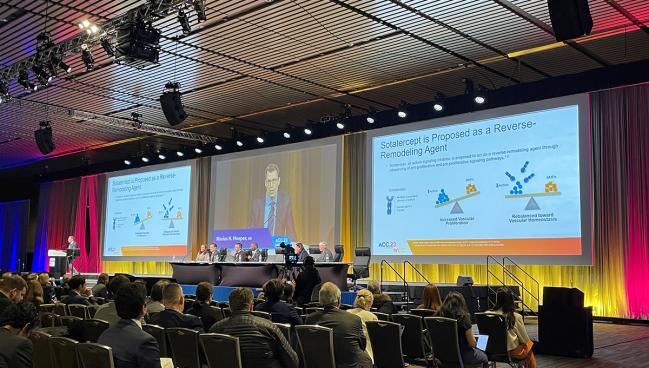STELLAR, ‘Impressive’ Results With Novel Drug Sotatercept in PAH
The randomized trial of this first-in-class injectable drew sustained applause at ACC 2023 when results were presented.

NEW ORLEANS, LA—Sotatercept, a first-in-class, investigational activin receptor type IIA-Fc fusion protein, taken on top of approved medications, improves 6-minute walk test over 24 weeks in patients with pulmonary arterial hypertension (PAH) compared with placebo, while also reducing other clinical endpoints such as death and nonfatal clinical worsening, results of the STELLAR trial show.
The drug was also well-tolerated, with the more-serious adverse events (AEs) reported in the placebo arm, although lesser AEs, including minor bleeding events, telangiectasia, and slight blood pressure increases were all slightly more common in the investigational group.
A range of secondary endpoints, from pulmonary vascular resistance to heart failure biomarkers to patient-reported symptoms, were all improved with sotatercept.
“Overall, I do believe these results establish the clinical utility of sotatercept, administered in combination with approved PAH therapies, as a new treatment for our patients with pulmonary arterial hypertension,” said Marius M. Hoeper, MD (Hannover Medical School, Germany), who presented the results here at the American College of Cardiology/World Congress of Cardiology (ACC/WCC) 2023 meeting.
As Hoeper explained, this novel class of medications is seeking to right the imbalance of anti- and pro-proliferative signaling pathways. In animals, he added, investigators have proposed that they may actually be able to achieve some degree of reverse remodeling, leading to “some regression of the disease.”
Responses to Hoeper’s presentation were enthusiastic, with Rhonda M. Cooper-DeHoff, PharmD (University of Florida, Gainesville, FL), the scheduled discussant, calling it a “very exciting boutique molecule” and predicting “we will see a lot of good things for our patients in the near future.”
Similarly, Geoffrey Barnes, MD (University of Michigan, Ann Arbor), called sotatercept a “very exciting therapy” with “very impressive outcomes,” nodding his head emphatically when Hoeper said he believed this drug could be started much earlier in the disease course, on top of the dual therapy patients are typically started on now.
In STELLAR, the time between diagnosis of PAH and entry in this trial was about 9 years, Hoeper noted.
“Even after that time we see such an impressive response here, so everybody, including myself, wonders what’s going to happen if we use this drug in patients newly diagnosed with disease,” he said, adding that one of the still-ongoing phase III studies is looking at this.
Carlos Santos-Gallego, MD, PhD (Icahn School of Medicine at Mount Sinai, New York), commenting on the study for TCTMD, said that he doesn’t use the term “paradigm change” lightly, but “this is more than a step forward. . . . This drug is very effective, very safe, but importantly, it is also the first agent with a novel mechanism of action.” Until now, all the approved drugs have been working via different pathways to achieve vasodilatation. Sotatercept, by contrast, “will be synergistic with all the previous drugs, and that’s perfect,” he said.
The findings were simultaneously published in the New England Journal of Medicine.
Key Results
STELLAR randomized 323 patients to placebo or sotatercept (Acceleron Pharma), given every 3 weeks for a total of 24 weeks. Patients were relatively young (mean age 48 years) and 80% female, with the majority in World Health Organization functional class (WHO-FC) II or III at baseline; two-thirds had idiopathic HF.
At week 24, results for the 6-minute walk test had improved by over 40 m in the intervention group and declined by 1.4 m in the placebo group (P < 0.001).
Significant improvements were also seen for pulmonary vascular resistance, NT-proBNP, WHO-FC category, time to clinical worsening or death, as well as a range of patient-reported metrics in the PAH SYMPACT score. Nearly 40% of sotatercept-treated patients, as compared with 10% of placebo-treated subjects, achieved an increase in a multicomponent endpoint that included 6-minute walk distance (increase of ≥ 30 m); improvement in NT-proBNP level (decrease of ≥ 30%) or maintenance/achievement of NTproBNP level < 300 pg/mL; and improvement in WHO-FC (a shift from class III to II or I, or from II to I) or maintenance in class II. The only domain that saw no improvement was cognitive/emotional scores, but according to Hoeper, these scores had been “normal” at baseline, so improvement wasn’t anticipated.
In an exploratory endpoint, he highlighted, “we saw about a 14-mm Hg decline in the mean pulmonary artery pressure, something we’ve never seen before in a drug that’s been used as add-on therapy in PAH.”
Responders and Side Effects
In response to questions from Cooper-DeHoff, Hoeper said that they are still trying to understand whether specific cocktails of drugs might be more likely to increase adverse events, or alternatively, ways of identifying patients who might benefit the most, and whether background therapy might boost that signal.
All of that work still needs to be further elucidated, he said, but his own experience as an investigator, backed up by the study data, is that the small group of “super-responders” who seem to get the best relief from sotatercept also are likely to be the ones to experience side effects. “But it really seems that the vast majority of patients have some response,” Hoeper noted.
There are more studies still underway, said Hoeper, but he predicted: “Once the drug is on the market, I still believe that the combination of an [endothelin receptor antagonist] and a phosphodiesterase-5 inhibitor will be standard up-front therapy, that’s not going to change, but we are not going to wait 9 years before we start this drug.”
Santos-Gallego agreed, saying, “I would start with this drug as soon as possible, because we don’t want our patients to deteriorate,” he said. “The sooner we start treating, the less remodeling they will have and the more we will be able to preserve their quality of life.”
Since the molecule is delivered as a subcutaneous injection every 21 days, it won’t increase the pill burden for patients, a welcome change, he predicted.
Assuming the agent gains swift regulatory approval, he expects sotatercept to make a real difference in patients’ lives, assuming access doesn’t prove insurmountable. “The limitation will not be the patient or the enthusiasm of the doctors, the main limitation will be the payers and insurance management companies,” he predicted. Those aside, he said, “I think that definitely this drug will be very meaningful to patients.”
In an editorial accompanying the NEJM publication, Darren B. Taichman, MD, PhD (University of Pennsylvania, Philadelphia), and colleagues also use the word “impressive” to describe the STELLAR results, but offer a few notes of caution. Since the trial enrolled a stable population, it’s not known whether the drug would deliver the same benefits in higher-risk, sicker, or less-stable patients, or those who have not received previous treatment. The relatively small number of patients with PAH related to connective tissue disease (just 15%) makes it difficult to extrapolate to this group, too.
“Future studies should seek to identify which patients may (or may not) benefit from sotatercept,” they conclude. Still, they write, “the STELLAR trial provides encouraging data for a new direction in therapeutic strategies for pulmonary arterial hypertension, and forces us to ask whether a new treatment era for the disorder has arrived.”
Shelley Wood was the Editor-in-Chief of TCTMD and the Editorial Director at the Cardiovascular Research Foundation (CRF) from October 2015…
Read Full BioSources
Hoeper MM, Badesch DB, Ghofrani A, et al. phase 3 trial of sotatercept for treatment of pulmonary arterial hypertension. N Engl J Med. 2023;Epub ahead of print.
Taichman DB, Leopold JA, Elliott G. Continued progress in therapy for pulmonary arterial hypertension. N Engl J Med. 2023;Epub ahead of print.
Disclosures
- Marius M. Hoeper is consultant for Acceleron Pharma, a wholly owned subsidiary of Merck & Co, and the funder of STELLAR.





Comments